10 Overlooked and Written Off 1990s Baseball Card Sets Worth Revisiting
The 1990s were an era of tremendous change in the world of baseball cards. The decade began with a “best of times” scenario where a product could do no wrong. But within a few years, the business side of the hobby saw drastic changes. Many of the speculators that took sports cards to new heights went away. Baseball went on strike, which further accelerated a massive crash.
But even as the business side of the hobby was in trouble, 1990s baseball cards brought on lots of innovation and change as companies tried to tap into the collective masses once again. The result was dozens of sets over the course of the decade that are great for varying reasons but, for whatever reason, haven’t held up in popularity in the decades since.
Here are ten sets of 1990s baseball cards that have either been brushed aside by the masses as new things came along, written off because they never amounted to much value or are just plain overlooked.
We’re not looking at what’s worth the most or what will appreciate over time. Rather, we want to shed some light on some fun 1990s baseball card sets that are worth your attention.
1990 Upper Deck Baseball
1989 Upper Deck Baseball gets a lot of the attention. But don’t discount the follow-up. It’s not as groundbreaking and it doesn’t have an iconic Ken Griffey Jr. rookie card to kick things off. What 1990 Upper Deck Baseball does have is a more refined design and so many great photos on both the front and the back.

The quality carried over from the debut year and other card companies were only starting to look at offering similar standards on a widespread scale.

The rookie card crop in 1990 Upper Deck Baseball isn’t full of high-dollar cards, but it does have some solid names from the era like Sammy Sosa, Juan Gonzalez and Larry Walker. If only there was a Frank Thomas.
This might not be an overlooked set, but it’s often dismissed simply because its value hasn’t held up. If you have a set or stack of commons sitting in a dark box, do yourself a favor, dig them out and simply marvel at the beauty.
1991 O-Pee-Chee Baseball
For many, 1991 O-Pee-Chee Baseball might not be a second look but rather a first. I mean, who wants what amounts to something that’s virtually identical to 1991 Topps Baseball? Here’s the thing — 1991 Topps Baseball has some of the best photography for the flagship set up until that point and probably top 10 all-time. But there’s soooooo much of it out there. 1991 O-Pee-Chee Baseball gives you all the same photos plus the added challenge of being relatively tough to put together (by 1991 standards). The bright card backs are another bonus.
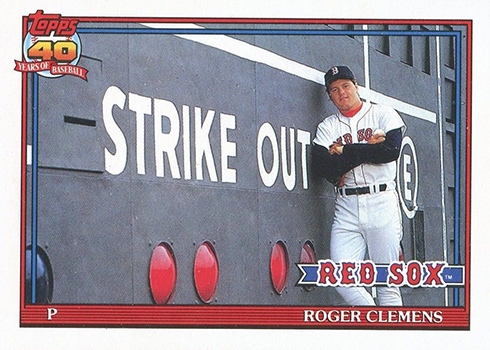
Chipper Jones highlights the rookies in the set.
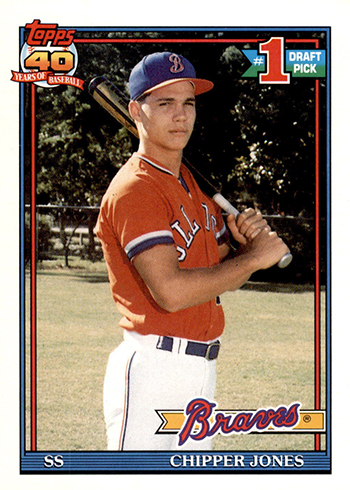
The fronts do look exactly the same as Topps, but the backs have different copyright info and bilingual text. This is one of two consecutive years that O-Pee-Chee didn’t bother to add their name to the front.
1992 Ultra Baseball
The Ultra brand made its baseball debut in 1991. And while that was heralded as being premium at the time, it really isn’t that much unless you hold the cards next to their Big Bird step-brother, 1991 Fleer Baseball. However, 1992 Ultra Baseball goes places. It’s slick, it had gold foil accents when not every set had gold foil accents and the photography is sharp. One could say it’s Fleer’s version of flagship Upper Deck or Topps Stadium Club, but in a good way.

From a checklist perspective, there’s not much to 1992 Ultra Baseball. Scott Brosius and Chad Curtis are about as good as the rookie cards get.
1992 Ultra also featured a growing number of insert sets. Among them is a tribute to Tony Gwynn. This included 2,000 autographs randomly inserted in Series 1 packs.
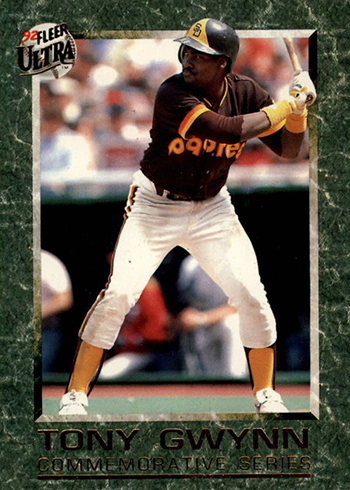
1993 Leaf Baseball
After coming into prominence in 1990, Leaf Baseball floundered for a couple of years. When the brand was rebooted in 1990, it was one of only a couple of premium products on the market. It had one of the year’s best rookie checklists as well. While they introduced Gold Leaf Rookies inserts in 1991, the interest just wasn’t there. That was the same in 1992.
1993 Leaf Baseball freshened things up. The design was overhauled, more inserts were added and Frank Thomas was featured throughout. Basically, it was brought up to date.
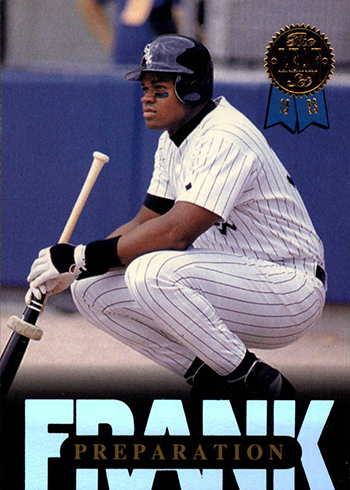
Another great thing about the set? The card backs, which use shots from the player’s city as a backdrop. Sometimes it’s the simple things that make a set standout.

1994 Collector’s Choice Baseball
1994 Collector’s Choice Baseball isn’t quite as slick as the main Upper Deck set or their growing stable of even more premium products. But it’s not exactly flimsy either.
What this product does right is that it was a budget product with a lower price point. Translation: kids were a big target. But it never panders to children like many other “kid-friendly” products do. 1994 Collector’s Choice Baseball kept things relatively simple in an evolving marketplace. As a result, it’s not just for young collectors. It certainly has some elements for the younger collector, but it can still be enjoyed by any age.
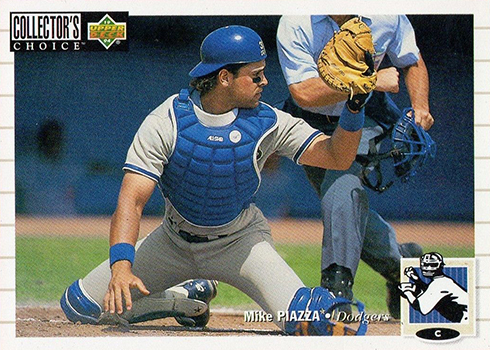
Every pack has a Silver Signature parallel. But the big chase at the time was for the Gold Signature cards. One per box, these were tough at the time and the concept was novel.
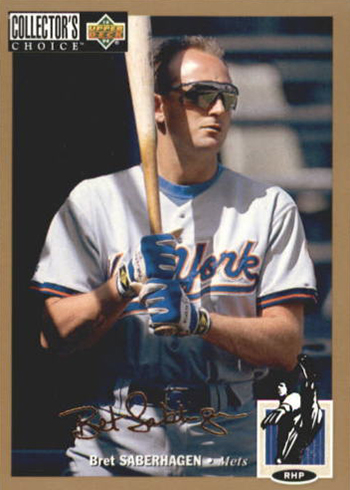
Notable rookies include Alex Rodriguez and one of the coolest Michael Jordan baseball cards.
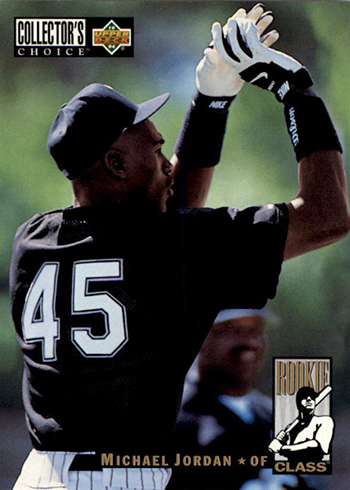
1996 Denny’s Holograms Baseball
Holograms are one of the greatest bits of technology, innovations, gimmicks or whatever you want to call it committed to cardboard. They were a part of the enduring food issue from the beginning. But what makes 1996 Denny’s Holograms standout is how the holograms are used.
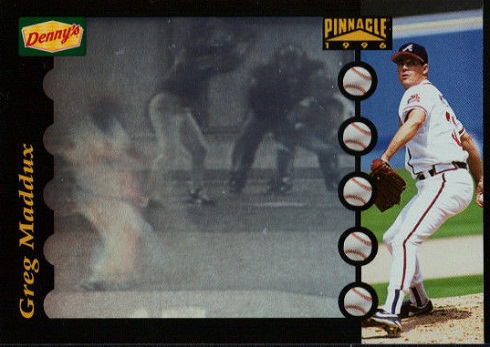
Made by Pinnacle, 1996 Denny’s Holograms Baseball adds motion to the mix, showing a holographic replay from a game in the main part of the set. It’s only about a second’s worth, but if you get the light just right and tilt it at the perfect speed, these cards are nothing short of glorious.
In addition to the base set are ten Grand Slam inserts and their Artist’s Proof parallels. These replace the action hologram with a Grand Slam logo. They might have a little more rarity on their side but not nearly the same cool factor.

1996 SPx Baseball
While we’re on the topic of holograms, if 1996 SPx Baseball seemed too expensive when it came out, don’t be afraid to look again. At the time $3.50 was a lot for a pack with just one card. It still is for a lot of people. The set essentially took Upper Deck’s popular Holoview inserts and gave them a product of their own.
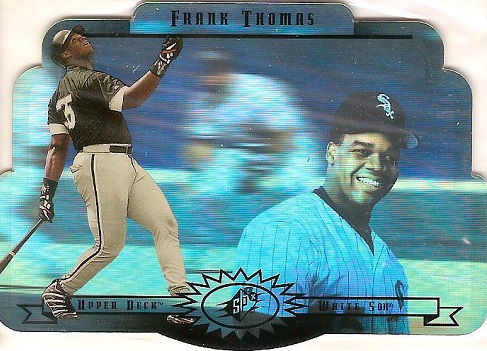
Every card is die-cut on thick card stock. But what really stands out is the massive hologram that makes up two of the three player images on the font. While the main images are flat holograms, many of the portraits rotate when you tilt the card. It’s like something out of a Harry Potter movie on some as faces offer a wink or a smile.
Over time, 1996 SPx Baseball has been all but forgotten as base cards gave way to more inserts. The only extra in this product are a Gold parallel, that’s bland, ten Bound for Glory cards, and a couple of Ken Griffey Jr. and Mike Piazza tribute cards. The two Hall of Famers also signed some of their cards.
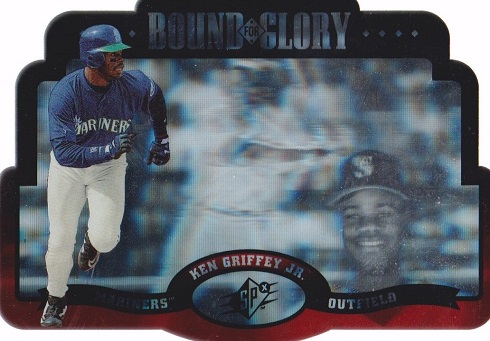
1997 E-X2000 Baeball
1997 E-X2000 Baseball is another set that was high-end for the day but has since dried up and become relatively ignored. It doesn’t have any major rookies for one. But it does have a unique approach to design and construction as well as some extremely tough inserts.
Base cards have a thick foil frame and a cloudy acetate inset. It was the first of a few similar set ups for the line, which replaced Emotion XL. Each of the 100 cards has two parallels, Credentials (/299) and Essential Credentials (/99). Like a lot of early numbered parallels, these have held up well on the secondary market, particularly key players with Essential Credentials cards.

Of the other inserts, A Cut Above is definitely the most popular. Die-cut in the shape of a circular saw, they not only look cool but they were exceptionally tough pulls at 1:288 packs. Top stars still fetch big sales.
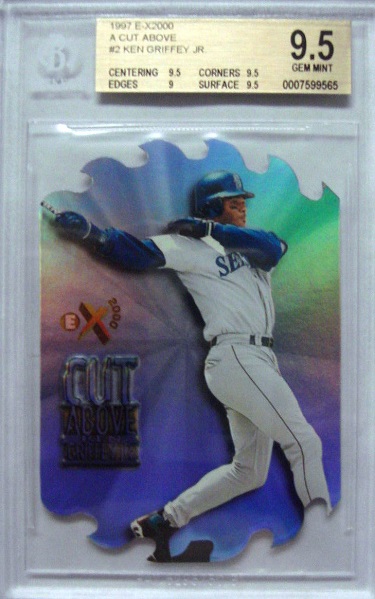
1997 Topps Screenplays Baseball
1997 Topps Screenplays Baseball is another product from the mid-1990s to experiment with using motion. Each card is lenticular. But rather than the couple of frames a Sportflics card gives you, these have 24 frames. That’s good for a second of action, similar to 1996 Denny’s Holograms.
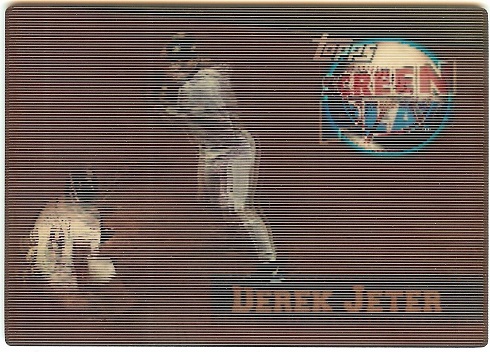
The checklist is small with just 20 cards. Each came packaged in a tin pack shaped like a movie reel to keep the Hollywood theme going. Players on the tin matched the player inside.
Each case has 21 packs — a full base set plus one of six Premium Series inserts.
The fact that it last one season should tell you how well it was received. Today you can find full sets at shows for a fraction of their original price.
1999 Upper Deck Century Legends Baseball
As the 20th century came to a close, there were plenty of retrospective sets across most sports. It was also a time that coincided with a major rise in popularity of retro-themed checklist. Of those, 1999 Upper Deck Century Legends Baseball is one of the best. The base set dedicates a huge portion to the game’s all-time greats, even managing to sneak a rare “Shoeless” Joe Jackson card into a MLB-licensed set.
But where 1999 Upper Deck Century Legends Baseball really stands out is with the autographs. Epic Signatures are inserted one per box. The checklist is a mix of then-current superstars like Ken Griffey Jr, Barry Bonds and Frank Thomas alongside many all-time greats like Nolan Ryan, Tom Seaver and Yogi Berra. They might not be the most desirable Hall of Fame signatures, but there is tons of depth and little fluff. Bill Mazeroski and Bucky Dent.
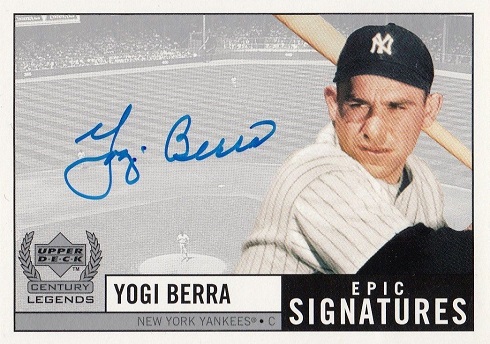
What are some of your favorite baseball card sets from the 1990s?
Comments? Questions? Contact Ryan Cracknell on Twitter @tradercracks.

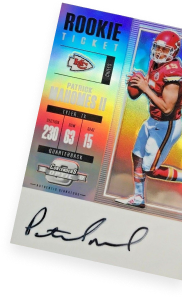

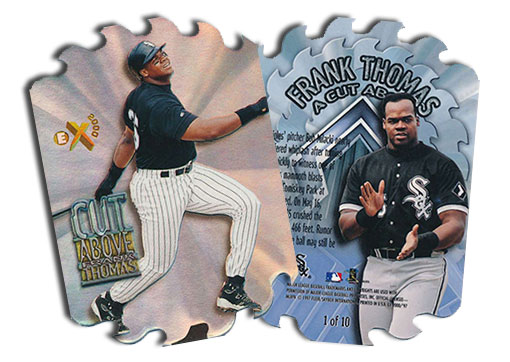




great article ryan
I have many cards of the 1st 5 sets from the 90’s above, including a completed box set of 1994 Collector’s Choice. It is disappointing to see how the value has depleted over the years but I will always enjoy the many, many 1990s insert subsets in my collection, especially those that include Puckett, Griffey Jr and Bagwell.
Great story!
Horrendously understated was the 1993 Cracker Jack 1915 tribute series. The set arrived at the perfect time with Ken Burns’ epic docuseries coming hot on its heels. The cards are absolutely beautiful and depending on the amount of oil the wrapper sucked up in the packaging, it was easy to find out who you had in your pack without even opening it. I still have a couple in their original wrapping today and only within the last couple years completed the set.
Also have to give a tip of the cap to the 1992 and 93 Action Packed legends series. 1992 may be the sharpest design of any AP set, while the 93 series has what I believe to be the only card to depict Abbott and Costello in their famed “Who’s On First” routine.
Ryan would you consider doing this same article for football cards?
I can certainly file it away, though personally I might need to seek out some help as I was more a baseball person myself then.
Hi. Great article…my favorite set of the 1990s had to the 1999 Fleer Sports Illustrated Greats of the Game Covers series! The packs were pricey, too, but each contained an autographed card.
I actually completed the autographed set, but I sold it shortly there after…looking at the autographed list of HOFs and deceased players availble, makes me regreted getting rid of them.
Still, one of the best looking sets ever made!
Definitely agree on 1990 Upper Deck, 1993 Leaf, and 1994 Collector’s Choice. Those were some of my favorites back in the ’90s and they still look good today. Aside from 1992 Ultra, I never collected any of the others, so there’s not much I can say about them.
I didn’t collect much in the late ’90s (things were getting a bit too weird and gimmicky), but one of my favorites when I started getting caught up was 1999 UD HoloGrFX. It’s easy to write it off as just another random Upper Deck experiment, but the clean card designs and attractive inserts help it to stand out. The small size (just 60 base cards and 30 inserts) is a bit of a problem and the only RC is Pat Burrell. A gold parallel of the base set and inserts adds some challenge to building the master set before you get to the real prize – UD Authentics autographs. Most were absolute nobodies, but the big names include Ken Griffey Jr., Carlos Beltran, and Chipper Jones. I still haven’t tracked down the Griffey… Upper Deck butchered HoloGrFX in 2000 and then retired the name. But the 1999 version still stands out.
Another 1999 product notable for its autograph set is 1999 Sports Illustrated Greats of the Game. Maybe it’s still too popular to count here, but, like UD Century Legends, it was at the leading edge of the upcoming retro kick and was essentially the SI photography equivalent of Topps Archives, right down to the type of players on the autograph checklist. Despite being out in front of the trend though, Fleer never quite figured out how to make it work consistently without SI, even with the great memorabilia inserts they added in 2000.
That seems to be a recurring theme with the ’90s – either something was done right at first and just couldn’t hold on or it was a bizarre experiment that never got a second look. By 2000, the hobby seemed to have decided on a direction and broke from the baggage of the past, somewhat ironically with a lot of retro content. The ’90s is a great decade to take another look at simply because of how many forgotten oddities are in there.
What about any of the initial Fleer FLair sets. Those cards were dope. Super premium look and feel all around. By far the most high end looking cards to hit the market for its time.
I agree on Fleer Flair. It has less fanfare today, but at the time it seemed just as great as the other 2 super premium sets that came out in 1993, Finest and SP.
Great article!
I would have liked to see 1995 Topps D-III included with this. Arguably one of Topps’ all-time biggest flops, but the cards were beautiful and introduced a great brand new 3-D printing technology. It’s the same technology that Topps has used since for some non-sport sets (especially Star Wars 3Di) and its Opening Day Stars inserts from the past several years.
* 1993 Leaf was a 1992 Ultra rip-off, right down to the marbleized design.
* No love for 1993 Upper Deck or 1994 Fleer? Both companies best efforts, and both the standard in what a base-level “flagship” baseball card set should be.
* Flair is a product that could never work today. And if it did, Topps would ruin it with gimmicks and 37 levels of parallels — like they do with every other set they make.
There’s lots of love to go around for lots of sets. These are just 10 of many.
1992 Ultra is a disaster. Ever opened a pack or looked at a boxed set? The cards often decide to become one big slab.
Can you please give me some information of how could i buy some of these sets?
Thank you
I prefer 1990’s cards over any current product. Much simpler base cards and inserts.
Some of the rarest inserts came from that decade including 1993 Finest Refractors, Epix, and the ultimate autograph inserts from Upper Deck Baseball Heroes.
Still chasing trying to find the Williams, Aaron, Ryan, and Reggie!
Enjoyed the look back. As a collector who collected all through the 90s I have to say that a couple of my favorite sets were Upper Deck’s Fun Pack sets from 1993 – 1994. Great pics, cartoons, heat-activated cards, stickers, glow-in-the-dark cards, kid photos, trivia, fold-outs, holograms, colorful designs all included in the base set and at a very affordable price. Obviously designed for kids it still had appeal for this adult collector.
I would be remiss not to give a nod to the Pacific sets of the 90’s too. Although most of the base lines other than Crown and Invincible weren’t that spectacular, Pacific took it’s inserts to a new level. They are still some of the most creative and innovative inserts out there.
Completely agree on Flair. Just beautiful cards. Agreed on SI cards as well.
……..No Stadium Club??? 1990 UD over 1991 Stadium Club is just silly.
You cannot add to a top ten with out subtracting…lose 1990 UD, Leaf (1990 would have been a better choice anyway), & one of those junky late 90s sets.
Also do not sleep on 1992 UD Minor League & UD Fun Packs which are actually pretty cool and should replace Collector’s Choice.
Nice inclusion of the Denny’s. I slipped a $5 to the lady serving us for extra packs and informed her the table tent featuring Gwynn was leaving with me.
What about 1990 Leaf? Leaf upped 1989 Upper Deck when it came back with a bang in 1990. No 1993 SP? That also broke barriers. I agree, 1991 Stadium Club and Flair were one of the most beautiful quality cards that had ever been produced at that time. What about mentioning there werent many cool inserts and no such thing as a die-cut, refractor or xfractor until the mid 90’s? 1992 Ultra was a beautiful card to compared to anything in 1992, but does not offer many stars, rookies or high end cards. Personally, I’ve never been a fan of Collectors Choice, and the Dennys cards were not all that cool. They say Dennys on them. There are some amazing hard to find inserts from the mid to late 90’s. EBay is a great place to find some of these.
1990 Leaf, 1993 SP and 1991 Stadium Club are all widely seen as gems of the decade. The intent of this piece was to remind people of some of the decade’s other great sets that might not get the same attention.
Hello Friend
I’m Chris and may be you can enlighten me some about some cards.
I thought this page was on error baseball cards, I didn’t see much.. Is their a site that will give you most of the cards.. I have a few of the Nolan Ryan cards #659 and #665 cards. which one is the error card.. One has the stats on back and the other has a lil story about him.. also a few of Juan Gonzalez 33a reverse neg.
I don’t know a lot about the cards but I came into a collection of a few thousand top players and cards..
All are in mint or nr.mt. any info you can offer would be appreciated..
I spent a few hours on these few pages and found out a lot of info, I came into this collection in 2007 and sold about 8 cards for 1200$… I have about 500 autographed cards in basketball most NBA Hoops about 50 Baseball autographed cards, a few hundred of vintage cards may be 30 football cards autographed..
All the cards I have the lastest date is from 1995 and a few 96 nothing recent, also I know there is a lot of shady people but thats not me.. I just want one person that knows the business and see the cards and autographs and they would know what I have and it’s worth.. I know i loss money hanging on to them but didn’t know better..
So any advice would help me out..
Thanks Chris
@Chris – Your best bet would be to take them to a card shop as they can look quickly at what you have.
I have to say that 1998 and 1999 Bowman Chrome ended up being my favorites. International, Refractor, International Refractor, Chrome Gold, Chrome Gold Refractor. Great variations. cards look good.
After stadium club popped out in 1991 then Fleet Ultra really changed the card game. the the Denny’s Holograms and SOx to hollow then the 97-98-99 Bowman Chrome. The 90s vamped the car collecting up. Mark and Sammy’s home run chase and then the GOAT Barry frickin Bonds the greatest most feared and exciting at bat to ever watch running parallel to the high end insert baseball cards with multi color patches autos, low numbered cards, different Refractors, Xfractors, Superfractors, colored Refractors, printing plates and so on. Baseball cards have been great ever since the late 90s but when Barry Bonds hot black balled I lost love for baseball. thank God the Giants won a few rings but I’m still passed Barry was black balled and that Dusty Baker pitched to Tim Salom. great article. thanks for the memories